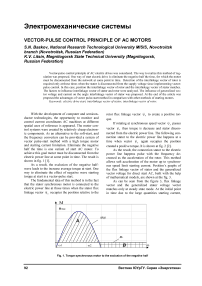Vector-pulse control principle of AC motors
Автор: Baskov S.N., Litsin K.V.
Журнал: Вестник Южно-Уральского государственного университета. Серия: Энергетика @vestnik-susu-power
Рубрика: Электромеханические системы
Статья в выпуске: 1 т.13, 2013 года.
Бесплатный доступ
Vector-pulse control principle of AC electric drives was considered. The way to realize this method of regulation was proposed. One way of start electric drive is eliminate the negative half the time, for which the motor must be disconnected from the network at some point in time. Detection of the interlinkage vector of rotor is required only at those times when the stator is disconnected from the supply voltage since implementing vector-pulse control. In this case, position the interlinkage vector of rotor and the interlinkage vector of stator matches. The factors to influence interlinkage vector of stator and rotor were analyzed. The influence of generalized vector voltage and current on the angle interlinkage vector of stator was proposed. At the end of the article was proposed the advantages of vector pulse-start method in comparison with other methods of starting motors.
Electric drive start, interlinkage vector of stator, interlinkage vector of rotor
Короткий адрес: https://sciup.org/147158228
IDR: 147158228 | УДК: 621.771.3
Текст научной статьи Vector-pulse control principle of AC motors
With the development of computer and semiconductor technologies, the opportunity to monitor and control current coordinates AC machines at different spatial axes of reference is appeared. The motor control systems were created by relatively cheap electronic components. As an alternative to the soft-start, and the frequency converters can be provided a system of vector pulse-start method with a high torque motor and starting current limitation. Eliminate the negative half the time is one variant of start AC motor. To achieve this goal motor must be disconnected from the electric power line at some point in time. The result is shown in fig. 1 [1].
As a result, the exclusion of the negative halfwave leads to the increase average torque at start. One way to eliminate the effect of negative wave starting torque at start is a vector-pulse start.
The fundamental idea of this method is in the fact that the stator synchronous motor is connected to the electric power line at those times when the stator flux linkage vector уs occupies the position relative to the rotor flux linkage vector уr to create a positive torque.
If rotating at synchronous speed vector у s passes vector у r then torque is decrease and stator disconnected from the electric power line. The following connection stator to the electric power line happens at a time when vector fjr s again occupies the position created a positive torque. It is shown at fig. 2 [2].
As the result, the connection stator to the electric power line happens pulse with the frequency decreased as the acceleration of the rotor. This method allows soft acceleration of the motor up to synchronous speed limit starting current. Position’s graphs of the flux linkage vector of stator and the generalized vector voltage for direct start AC, built with the help of mathematical models, are shown at the fig. 3.
As can be seen from the figure 3, flux linkage vector and the generalized stator voltage vector matches only at steady state mode. At the initial point in time due to the large quantities starting current,
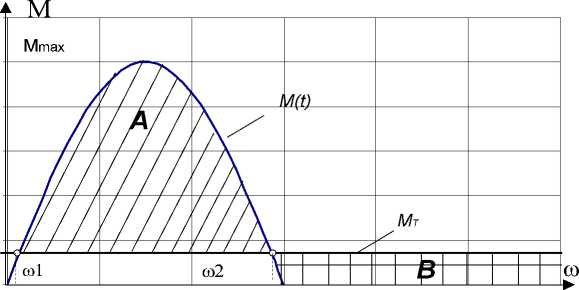
Fig. 1. Torque synchronous motor to the exclusion of the negative half
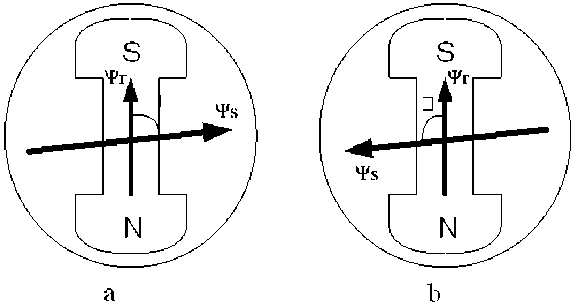
Fig. 2. Position of the flux linkage vector of the stator: a – positive value of the electromagnetic torque; b – negative value of the electromagnetic torque
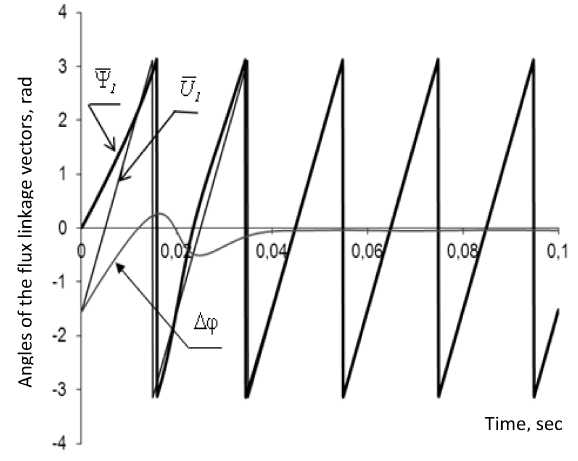
Fig. 3. Changing the position of the flux linkage vector and the generalized stator voltage vector
position flux linkage vector of the stator is much different from the generalized vector voltage.
Angle of the flux linkage vector of stator must be determined both when stator connect or disconnect to the electric power line. If stator disconnect from the electric power line then flux linkage vector of stator will match with flux linkage vector of rotor because at this time magnetic field is created in the engine only by the fading of the magnetic field of the rotor. Graphs of the changes angles flux linkage vectors with periodic disconnect stator from the electric power line are shown at the fig. 4.
Motor start and flux linkage vectors rotate with different speeds. It is associated with electromagnetic transients in the rotor circuit (with the presence of the rotor winding leakage inductance). However, the speed of rotation flux linkage vector of rotor higher than rotor’s speed of rotation in the nominal steady state because slip at start much more. Graphs of the angles of rotation flux linkage vectors of stator and rotor and the angle of rotation of the rotor are shown at fig. 5.
As shown above, lag flux linkage vector of the rotor relative flux linkage vector of the stator more than 180 °C causes negative peaks of the moment. The speed of rotation of the rotor flux is influenced by both electrical factors (resistance and reactance of the rotor winding) and mechanical (moment of inertia and load torque).
So, the advantages of vector-pulse start method are:
-
– this method can be used for low-voltage motors and motors with high voltage;
-
– natural automatic synchronization with the electric power line and automatically enter into the stationary synchronous mode;
-
– increased value of the starting torque;
-
– ability to limit inrush current when using control power keys. [3].
Электромеханические системы
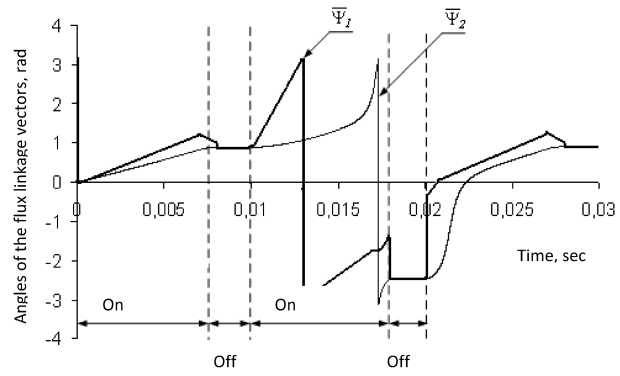
Fig. 4. Angles of the flux linkage vectors with periodic disconnect stator of AC motor from the electric power line
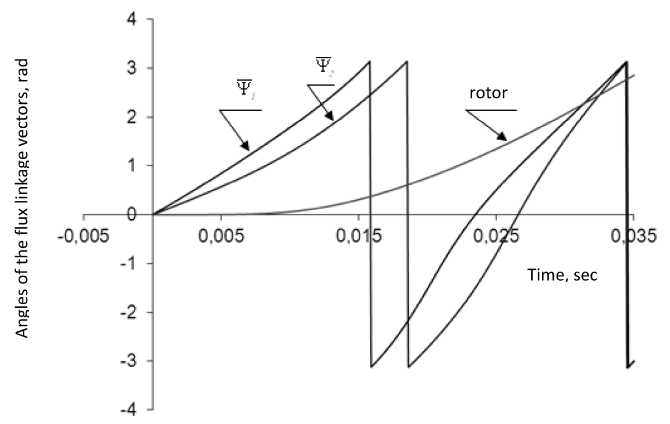
Fig. 5. Graphs of position flux linkage vectors of the stator and the rotor and rotation angle of the rotor at start
Conclusions:
-
1. Negative values of the electromagnetic torque asynchronous motor are caused to lag flux linkage vector of the rotor relative flux linkage vector of the stator more than 180 °C, that is, if the flux linkage vector of the stator ahead the flux linkage vector of the rotor electromagnetic torque is positive ( Дф 12 > 0). The maximum torque (proportional to the imaginary part of the vector product) will be achieved, if the vector T 1 ahead vector T 2 by 90 ° ( Дф 12 = 90 ° ).
-
2. Generalized vectors u 1 and i 1 affect the angle of the flux linkage vector of the stator. Position flux linkage vector of the stator and the generalized voltage vector matches only at steady state. At the initial moment of time, due to the large quantities starting current, position flux linkage vector of the stator is much different from the generalized voltage vector. To determine the position flux linkage vector of the stator when starting to use the differential equations of the generalized machine.
-
3. At start-up flux linkage vector of the rotor rotates slower than flux linkage vector of the stator. It is associated with electromagnetic transients in the rotor circuit (with the presence of the rotor winding leakage inductance) and mechanical inertia of the rotor.
-
4. To detection position of the flux linkage vector of the rotor is required only at those times when the stator is disconnected from the supply voltage since vector-pulse control.
Список литературы Vector-pulse control principle of AC motors
- Басков, С.Н. Векторно-импульсный способ пуска синхронного двигателя/С.Н. Басков, М.Н. Давыдкин//Наука и производство Урала. -2008. -№ 2. -С. 7-11.
- Овчинников, И.Е. Способ импульсного пуска синхронных машин/И.Е. Овчинников, Г.Н. Тер-Газарян, Ж.Д. Давидян, В.Н. Рябов//Электротехника. -1987. -№ 3. -С. 33-36.
- Ткачук, А. Тиристорный преобразователь для плавного пуска высоковольтных асинхронных двигателей/А. Ткачук, В. Кривовяз//Силовая электроника. -2008. -№ 2. -С. 54-58.

